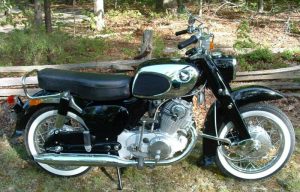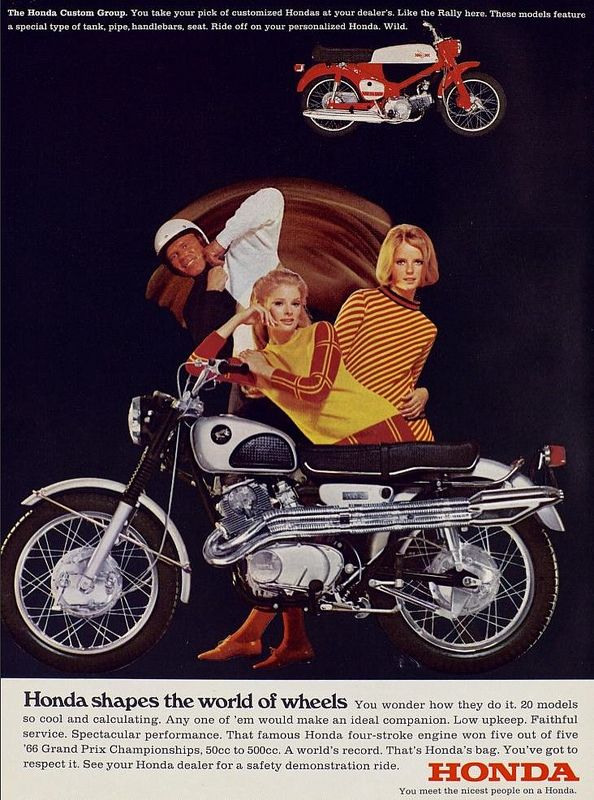My friend Graves owns several antique bikes, including a very nice – and road ready – ’67 Honda Dream. Many of you know about this bike – it’s the one Honda used to both establish itself in the U.S. market and also to almost singlehandedly change the public perception of bikers and motorcycling.
Remember the ad campaign? You meet the nicest people on Hondas.
Not just Marlon Brando types on BSAs and Hell’s Angels on Hogs.
The Dream helped popularize motorcycling and expanded its appeal to middle class America, much like Arnold popularized weight training. Arguably, it is the machine that set the stage for all the good stuff we enjoy today: Bikes for everyone – and anyone can be a biker.
It all started here, with the Dream.
My friend Graves owns a bunch of these things. He lets me ride them when I am feeling nostalgic.
So here I am facing a bike that’s 50 years old – a time machine on two wheels.
And it does look old. Many of the parts appear to be stamped steel and look heavy. Even the chain is completely covered in a stamped steel casing – to keep oil from getting on those nice people’s clothes, of course!
It has (for a bike) very small wheels – with very skinny tires – and of course, manual (cable-pull) drum brakes on both of them. A single tiny speedometer sits almost flat ahead of the handlebars. The seat is also flat and very Moped-like. You sit tall – and low. This makes the bike very controllable when it’s not moving, almost impossible to drop. At the time, this probably helped sell the bike to people who had never ridden or even sat on a bike before.
So, too, the electric start.
There’s a back-up kicker also – but you can effortlessly key the twin-cylinder engine to life by . . . turning the key. No doubt, ’60s-era women found this very appealing (while the guys could still do it manually – which no doubt appealed to them).
You’ve got just four gears; remember, it’s 1967.
Now comes the moment of truth. Graves heads out on my ’83 Silverwing.
I prepare to follow, easing the Dream’s no-hydraulic-assist clutch out, anticipating some herky-jerkyiness. But the Dream just glides forward.
The 300 cc parallel twin has decent pull, too. It does not sound old. Twist the throttle and it sings like a modern overhead cam Japanese twin – which is exactly what it is, of course. In addition to the OHC layout, the engine is aluminum with steel liners for the cylinders – a technological Great Leap Forward for the 1960s. It has excellent power – more than some of the bigger CC engines of its time and with superior smoothness and almost no vibration.
I am keeping up with the ‘Wing!
Graves has warned me about the brakes – which are definitely 1960s (no, 1940s) technology. But the rest of the bike feels good. Modern, even. Acceleration isn’t swift but it’s not far off the pace of a late model 200-250 cc bike. The Dream gets itself to 45-50 MPH easily enough and seems comfortable there. Graves says he used to ride this bike on I-95 near Richmond back in the ’70s.
I believe him.
The Dream doesn’t “corner” in the way we talk about bikes today but it does handle ok in the sense that it’s easy to keep it on track and steering is light and easy. It goes where you turn the handlebars, very much like a bicycle. Anyone could ride this bike.
And many did. Honda sold them as fast as they could be stamped out; as many as 100,000 of them from circa 1961 to the final year, 1967.
After we stopped I told Graves I thought that if you upgraded the brakes, the Dream could be comfortably and safely ridden almost anywhere except the Interstates. He agreed.
And we both agreed that Honda did a brilliant job designing a bike to get people who’d never ridden – and thought riding was for apes only – to throw a leg over!
If you like what you’ve found here, please consider supporting EPautos.
We depend on you to keep the wheels turning!
Our donate button is here.
If you prefer not to use PayPal, our mailing address is:
EPautos
721 Hummingbird Lane SE
Copper Hill, VA 24079
PS: EPautos stickers are free to those who send in $20 or more to support the site. 











I have friends that have nick-named these “nightmares”, lol! One significant improvement was to ditch the original and/or replica straight tread tires. Fortunately the ’85 Honda 500 VFR used a 100/90-16 sport tire, and that is what I currently use on the 305 Dream, which improved the handling tenfold! The solid non-folding footpegs can be a drag (literally) but at that point your probably pushing the envelope of safety for the hidden “springer” front suspension, and the woefully weak rear shocks. It does have a manual steering damper, unlike its smaller 150cc & 160cc siblings, but the modern tires make even that unnecessary. The brakes, well, those are another matter entirely. Large, heavy, single-leading shoe type, with a cable pull for the front, and pedal rod for the rear. I ease off the throttle to slow down, too much pulling on the front brake just stretches an expensive cable, lol! It takes a cautious riding style to keep these from biting you, especially after riding bikes 15 years newer with hydraulic dual-disc brakes and other “amenities” not installed on the Honda Dream.
By comparison to its contemporaries of the 60’s, however, it was a well mannered, forgiving machine that was virtually indestructible, and made for the more “civilized” rider. If you wanted a rocket in the same displacement class, you went out and got the Suzuki X-6, their 6-speed, 120 mph 250cc two-stroker, which I have one of as well, but that’s another story.
A laugh is in rain with the four leading shoe front brake on a ’73 Guzzi Sport 750.
Well, at least you can laugh about it if the deep water slowed you down.
Brakes are overrated. All they do is slow you down!